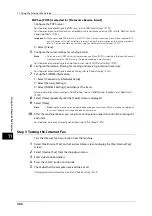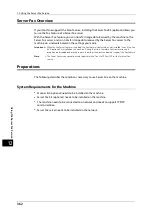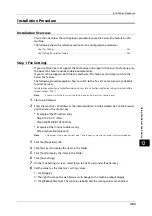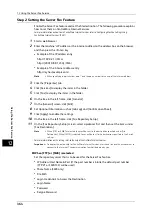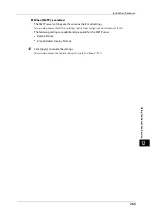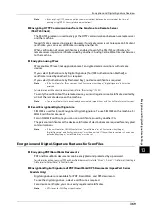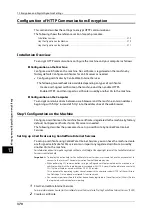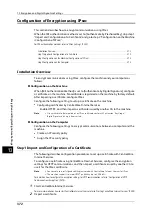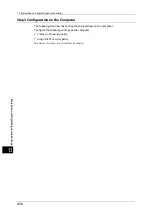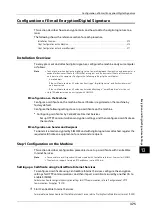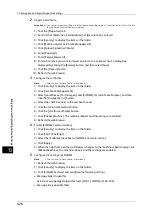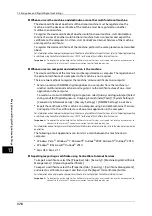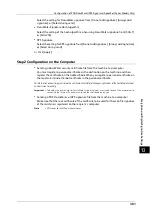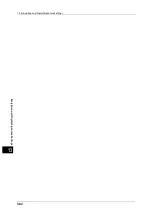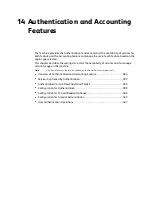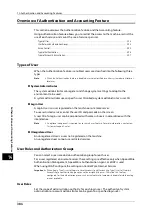
Encryption and Digital Signature Overview
369
En
cr
yp
ti
o
n
a
n
d
D
ig
it
a
l
S
ign
at
ur
e
S
e
tt
in
gs
13
Note
•
By encrypting HTTP communications, communications data can be encrypted at the time of
printing using IPP (SSL encrypted communications).
Encrypting HTTP Communications from the Machine to a Remote Server
(SSL/TLS Client)
The SSL/TLS protocol is used to encrypt the HTTP communications between a remote server
and the machine.
No certificate is required in general. However; if a remote server is set to require an SSL client
certificate, you can use a certificate issued by another CA.
When verification of server certificates is enabled to verify the SSL/TLS certificate of a
remote server, import a certificate issued by another CA using CentreWare Internet Services
to the machine.
Encryption using IPsec
IPsec enables IP-level (not application-level) encrypted communications with remote
devices.
If you select [Authenticate by Digital Signature] for [IKE Authentication Method], a
certificate issued by another CA is required.
If you select [Authenticate by Preshared Key], no device certificate is required.
Note
•
If the certificate for IPsec contains the V3 extension (keyUsage), "digitalSignature" bit must be
asserted.
For information on IKE authentication methods, refer to "IPsec Settings" (P.202).
To verify the certificate of the remote device, you must register a root certificate created by
a CA of the remote device on the machine.
Note
•
To use certificates that have already been created, import them with CentreWare Internet Services.
E-mail Encryption/Digital Signature
S/MIME is used for E-mail Encryption/Digital Signature. To use S/MIME on the machine, S/
MIME certificates are used.
For an S/MIME certificate, you can use a certificate issued by another CA.
The personal certificates or the device certificates of destinations are required for encrypted
communications.
Note
•
If the certificate for S/MIME contains an "email Address" or a V3 extension (keyUsage),
"digitalSignature" and "keyEncipherment" must be asserted. If the certificate contains v3 extension
(extendedKeyUsage), "emailProtection" must be set.
Encryption and Digital-Signature Features for Scan Files
Encrypting PDF/DocuWorks Documents
PDF and DocuWorks documents can be encrypted and protected by a password.
For information on how to encrypt PDF and DocuWorks documents, refer to "5 Scan" > "E-mail" > "File Format (Selecting a
File Format for Output Data)" in the User Guide.
Encryption/Digital Signature of PDF/DocuWorks/XPS Documents (ApeosPort Series
Models Only)
Digital signatures are available for PDF, DocuWorks, and XPS documents.
To use the digital signature, a device certificate is required.
For a device certificate, you can use any registered certificates.
Note
•
XPS stands for XML Paper Specification.
Summary of Contents for ApeosPort-V 6080
Page 1: ...ApeosPort V 7080 ApeosPort V 6080 DocuCentre V 7080 DocuCentre V 6080 Administrator Guide ...
Page 13: ...13 Activity Report 727 EP System 731 Glossary 732 Index 735 ...
Page 14: ...14 ...
Page 62: ...2 Paper and Other Media 62 Paper and Other Media 2 ...
Page 88: ...3 Maintenance 88 Maintenance 3 ...
Page 110: ...4 Machine Status 110 Machine Status 4 ...
Page 296: ...5 Tools 296 Tools 5 ...
Page 346: ...9 Scanner Environment Settings 346 Scanner Environment Settings 9 ...
Page 354: ...10 Using IP Fax SIP 354 Using IP Fax SIP 10 ...
Page 366: ...12 Using the Server Fax Service 366 Using the Server Fax Service 12 ...
Page 382: ...13 Encryption and Digital Signature Settings 382 Encryption and Digital Signature Settings 13 ...
Page 734: ...16 Appendix 734 Appendix 16 ...
Page 744: ...Index 744 Index ...






